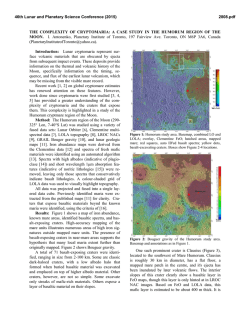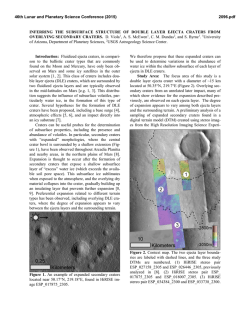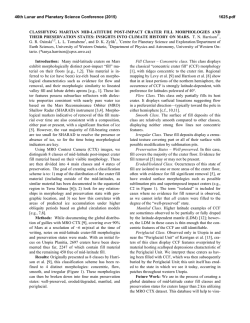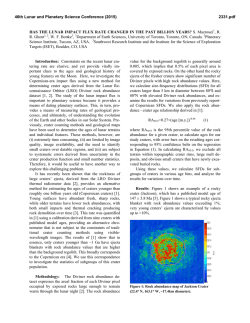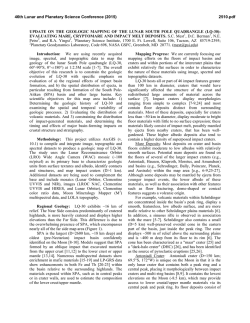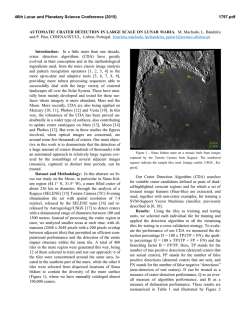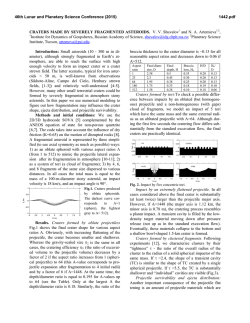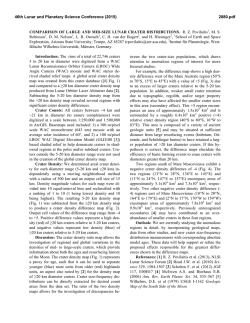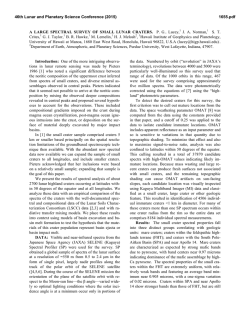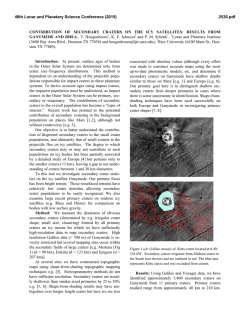
CRATER MORPHOLOGY IN THE PHOENIX LANDING ELLIPSE
46th Lunar and Planetary Science Conference (2015) 2511.pdf CRATER MORPHOLOGY IN THE PHOENIX LANDING ELLIPSE: INSIGHTS INTO NET EROSION AND ICE TABLE DEPTH. E.Z. Noe Dobrea1,2 and C.R. Stoker2, C.P. McKay2, A.F. Davila2,3, M. Krčo4. 1 Planetary Science Institute, Tucson, AZ, 85719 ([email protected]); 2NASA Ames Research Center, Mountain View, CA; 3SETI Institute, Mountain View, CA; 4Cornell University, Ithaca, NY. Introduction: Icebreaker [1] is a Discovery class mission being developed for future flight opportunities. Under this mission concept, the Icebreaker payload is carried on a stationary lander, and lands in the same landing ellipse as Phoenix. Samples are acquired from the subsurface using a drilling system that penetrates into materials which may include loose or cemented soil, icy soil, pure ice, rocks, or mixtures of these. To avoid the complexity of mating additional strings, the drill is single-string, limiting it to a total length of 1 m. The scientific rationale behind the landing site selection for the Icebreaker mission lies in the presence of an easily accessible, shallow ice table. Ice is an interesting target in the search for evidence of modern life on Mars for two reasons: 1) it can provide liquid water when conditions of temperature and pressure are suitable, thus allowing for biological activity; 2) icerich ground may prevent destruction of organics by atmospheric oxidants. The ideal location on Mars to search for biomarkers could be the ice-bearing permafrost in the northern plains [1; 2]. Here, the presence of ice near the surface (4.6 cm deep at the Phoenix site) provides a source of H2O. The atmospheric surface pressure above the triple point stabilizes the liquid phase even of pure water. Thus, all that would be required to provide liquid water activity capable of supporting life is sufficient energy to melt the subsurface ice. This may occur periodically during high obliquity periods (HOPs), when solar insolation near polar latitudes is higher than at present. Such HOPs, which have a recurrence time of c.a. 125 kyr , have reached obliquities of up to 35º over the past 3 million years, and up to 45º at earlier epochs [3]. Such high obliquities can result in peak surface temperatures above 0ºC in the high northern latitudes at obliquities >40º, and temperatures above –20ºC for an obliquity as low as 35º [4]. [5] showed that when obliquity is 45º melting can occur 50 days per year in the high northern latitudes. Hence, ice-bearing permafrost in the northern plains of Mars could be a site of recent habitability compatible with the survivability of radiation-tolerant microorganisms. Of particular importance to landing site selection is the development of a framework with which to understand the depositional history of the region. In particular, we seek to better understand the distribution of ice as well as the erosional history of the region. If the site has been a net depositional site and over a meter of sediment has been deposited since the last period of habitability, the current Icebreaker sampling system will not be capable of accessing the sediments that were exposed to liquid water. On the other hand, if the site has experienced net erosion of over a meter, then these sediments will have been removed. Although the former scenario presents a significant obstacle to mission success, the latter is not necessarily a problem, and may even be preferable, as erosion may expose deeper (and therefore more protected) sediments associated with previous periods of habitability. Hence, we seek to address the question: has the terrain within the proposed landing site been a site of net erosion or deposition within the last 5 Myr? In order to address this question, we performed an extensive morphological examination of the craters within the landing ellipse. We searched for the freshest craters of varying sizes and estimated the net level of deposition since their formation by searching for ejecta blocks and measuring the sizes of these blocks. The age of these craters was estimated from the crater production rates constrained by previous studies [6; 7]. Procedure: We inspected all of the HiRISE and CTX images acquired in this region to date, covering an area of 4000 km2 that included the Phoenix landing ellipse, with the aim of identifying and cataloguing every crater within the ellipse. The ice-cemented ground and associated periglacial processes affect the appearance of craters over time, and allow to distinguish fresh craters from modified ones. Fresh craters were identified by the presence of a bowl-shaped depression and potentially a rim. Modified craters were identified by the presence of concentric and/or radial fracture patterns, or circular areas corresponding to clearing pre-existing slow-forming patterns (e.g., boulder piles, 30-meter polygons). Once all the craters in the region were identified, we classified the craters on the basis of size, degree of degradation, target morphology, and the presence of ejecta blocks. The degree of degradation was inferred from the state of the crater floor, rim, and ejecta as well as the degree of pattern development and boulder sorting. From these characteristics, we identified the freshest craters of each size grouping and assessed these for the presence of ejecta boulders at HiRISE scales. Ejecta boulders were distinguished from nonejecta boulders by their distribution with relation to the 46th Lunar and Planetary Science Conference (2015) crater. Ejecta boulders increase in spatial density with proximity to the crater, and may be distributed radially away from the crater. Results: We identified over 2000 craters in the 4000 km2 region of interest and binned them into groups on the basis of crater size and degree of modification. We found that it is fairly straightforward to identify a pattern of modification for each range size. Modification of craters ranging in size from ~100 m to a couple of km typically involves the loss of relief of both the rim and the crater bowl, as well as the formation of a network of co-centric and radial fractures or ridges within the former bowl. Because bowls disappear more readily than rims, we attributed the loss of relief to the solifluction of ice-rich soil. On the other hand, craters smaller than 100 m typically exhibit loss of their bowl by in-filling with smooth, higher-albedo material inferred to be a combination of frost and dust. Overall, we found that ejecta boulders are visible down to the resolution limit of HiRISE (~30 cm/pixel) for most craters larger than 200-300 m in diameter. Absence of ejecta boulders is typically associated to the most modified craters (i.e., craters with no apparent relief and craters whose interiors are covered with boulder piles), and craters smaller than about 200-300 meters (Fig. 1). According to [8], craters 250 meters and larger form roughly every 5 Myrs in a 4000 km2 area. Hence, it is inferred here from the identification of ejecta boulders down to the limit of resolution of HiRISE for all but the oldest and smallest craters that the region not has experienced a net deposition of 1 meter or more since the formation of these craters. The absence of ejecta blocks in most craters smaller than 200-300 meters is particularly intriguing as it suggests impacts onto a layer of ice-cemented, friable, or unconsolidated soil approximately 20-30 m thick [9]. This layer likely overlies a basement of stronger material that is only exposed by larger impactors, and does generate ejecta blocks in most larger craters (>300 m). Our inferred stratigraphy in his region is consistent with observations from SHARAD [10], which identifies a radar return at depths of 15-66 meters in the Phoenix landing ellipse. The presence of significant amounts of water ice, inferred from modeling and observations by GRS and the Phoenix lander [11], could explain the lack of ejecta boulders as due to sublimation of cementing ice post-impact. 2511.pdf References: [1] McKay et al. (2013) Astrobiology, 13(4) 334-353. [2] Stoker et al. (2010) JGR 115, E00E20. [3] Levrard et al. (2004) Nature 431, 10721075. [4] Costard et al. (2002) 293, 110-113. [5] Richardson and Mischna (2005) JGR E3. [6] Malin et al. (2006) Science 314, 1573. [7] Daubar et al. (2013) Icarus 225, 506-516. [8] Hartmann (2005) Icarus 174, 294-320. [9] Mellosh (1996) Impact Cratering. [10] Putzig et al. (2014) JGR 119, 1936-1949. [11] Mellon et al. (2009) JGR, 119, 1936-1949. Figure 1. Two craters located about 2.6 km apart and differing in size by 100 meters. Top: Fresh-looking, 200 meter crater exhibits a clear bowl shape and smooth, higher albedo mantling deposit in its interior. Boulders around the crater do not exhibit an increase in concentration with proximity to crater, suggesting that they are not ejecta. Sun is from the top. Bottom: Modified 300 meter crater exhibits a flat, cocentrically fractured floor and clear evidence for ejecta boulders.
© Copyright 2025
